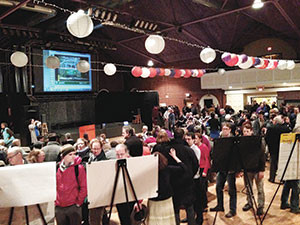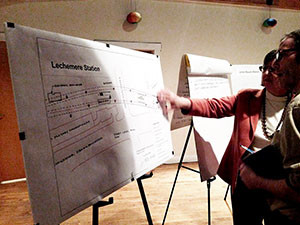By Josie Grove

Redesigned Green Line coming into sharper focus
A raucous crowd packed the Armory for a first glimpse at how a bare bones Green Line Extension (GLX) might look in Somerville. The project must find $1 billion in savings in its construction, or be eliminated altogether.
Over fifty people spoke at the meeting. Opinions were split: some want the state to come up with the funding to continue project just as it was, and some can make peace with the scaled-back version. Either way, say residents, the Green Line Extension must come. “I think the train is first and foremost important, as long as it’s not eliminated totally,” said Janet Taylor, who has been hearing about the GLX since she moved to Somerville in 2004. “I feel like everyone in the area has been strung along for so long.”
The GLX broke ground in December 2012, funded by a Federal Transportation Administration grant for the first $1 billion, and the state put up $1 billion to match it. Last summer, the estimated cost shot up to $3 billion, and the Massachusetts Department of Transportation has been working to get the project back under budget.

Details of how GLX station designs will likely be modified were furnished to the public.
Jack Wright, the GLX interim project manager, began by explaining that there simply was no more money. “The federal contribution is set, the state contribution is set, and there’s a very small margin of other contributions,” he said. Since the budget is fixed, Wright’s task is to find $1 billion in savings by redesigning major aspects of the project, including stations, bridges, and the maintenance facility. “The redesign effort is going to touch every part of the project,” he said.
The redesign is a balance between saving and meeting requirements, said Wright. The project must fulfill the Full Funding Grant Agreement (FFGA) to keep the federal money. To do so, the project has to do everything promised in the grant proposal, including deliver public transit to Union Square and build the community bike path extension. Besides the FFGA, the Green Line needs to be accessible to disabled people, meet state accessibility requirements, and pass state and federal environmental impact assessments.
To achieve cost savings within those limits, Wright and his team developed ten “areas of focus” for cuts, including the maintenance facility, stations, the community path, construction work hour limitations, retaining and sound walls, and power and signals. “We’re looking at simpler, less expensive ways to achieve the same goal,” said Wright.
The reimagined stations resemble the outer parts of the existing Green Line, concrete center platforms and street-level crossings, a few with fare vending machines. “Stations were very substantial when we came on board, and the stations you see on the sketches now are anything but substantial,” Wright said. “We maintain the functionality and, of course, the accessibility.” Some took umbrage at the minimal stations, but concrete platforms are more substantial than some existing Green Line stations, such as Fenwood Road, where passengers get on and off in the middle of South Huntington Avenue.
The size of the maintenance facility has decreased to a forty-car light maintenance station, and while it will save money for the project, Wright explains that the decrease is “a hit to operations.”
There will be further adjustments to bridges, power, signals, and the cross-section of the tracks. The look of the community path could change, but Wright’s team is trying to include it, since it is part of the FFGA.
Union Square service is also part of the FFGA, but Wright said, “Cost-cutting efforts include all kinds of things, including a commuter rail stop at Union Square,” although he questions if commuter rail at Union Square would fulfill the federal grant agreement. But, Wright said, “Everything’s on the table until we find a fatal flaw.”
“We believe we will be able to achieve $200 million [in savings] and maybe even more on just stations alone,” said Wright. “Scaling back the maintenance facility will save $70 million, maybe even a little more, 80 million. We get close to $300 million.”
The reaction to Wright’s presentation was passionate. A raucous crowd, clapping when they said they wanted the train, a few people giggling at the scaled-down station designs. Yelling for the governor and T officials to be present.
People refusing to accept that the transit system can’t get more funding in a climate that cut late night service. Something about asking for more money from the legislature and auctioning off naming rights for the stations. One of the few positive comments came from Lynn Weissman, “I want to commend the process for the transparency.”
Several elected officials spoke to express the need for the Green line project. State Representative Denise Provost said, “I’m a little stunned by the austerity of some of these proposals, but I like the underlying supposition that the project is moving forward.” Alderman at Large Bill White was even more frank, saying, “I’m incredibly hopeful but also frustrated. Tonight we don’t have torches and pitchforks but I can’t guarantee what will happen after the May meeting.”
The next steps of the process will happen quickly. After four more community meetings over the next two months, Wright and his team will make their report to the MBTA fiscal control board. “I won’t speak for the governor, but there is plenty of support to get to where we need to get to,” said White. “There’s reason for optimism, there’s hope, but there’s a long way to go.”















Build it and the yuppies will come!
In short,
a crappy green line or not green line. Yay! Like those folks who get married to a person they dislike just so they don’t have to be alone!